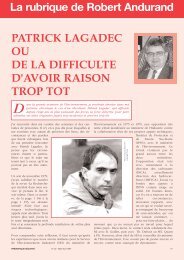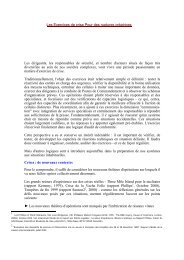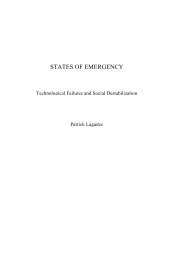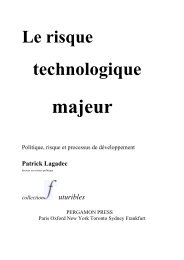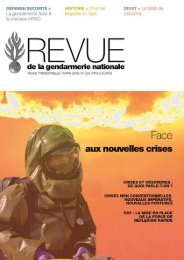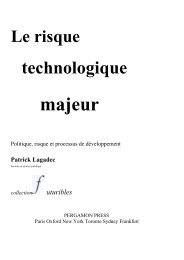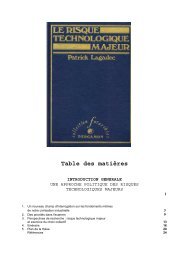Rapid Reflection Forces put to the reality test - patricklagadec.net
Rapid Reflection Forces put to the reality test - patricklagadec.net
Rapid Reflection Forces put to the reality test - patricklagadec.net
Create successful ePaper yourself
Turn your PDF publications into a flip-book with our unique Google optimized e-Paper software.
case study<br />
<strong>Rapid</strong> <strong>Reflection</strong> <strong>Forces</strong><br />
<strong>put</strong> <strong>to</strong> <strong>the</strong> <strong>reality</strong> <strong>test</strong><br />
Pierre Béroux, Xavier Guilhou, and Patrick Lagadec outline how <strong>the</strong> <strong>Rapid</strong> <strong>Reflection</strong><br />
Force concept – described in CRJ in 2006 – has now proved itself as a pivotal <strong>to</strong>ol for EDF’s<br />
senior management when <strong>the</strong>y are confronted with risks and crises<br />
IN 2006, THE AUTHORS LAID OUT A<br />
new concept for crisis leadership in CRJ<br />
which Électricité de France (EDF) was <strong>the</strong>n<br />
just beginning <strong>to</strong> implement at <strong>the</strong> highest<br />
level: <strong>the</strong> <strong>Rapid</strong> Refl ection Force (RRF).<br />
One year on, EDF’s <strong>to</strong>p management now<br />
systematically relies on it. It has proven <strong>to</strong> be<br />
a crucial platform for innovative <strong>net</strong>working<br />
dynamics inside and outside EDF, and has<br />
spurred <strong>the</strong> company <strong>to</strong> tackle <strong>the</strong> challenges<br />
of chaotic environments that characterise<br />
21st century crises more effectively.<br />
PositiVe DYnaMiCs<br />
The RRF is a group that’s task is <strong>to</strong> help<br />
<strong>the</strong> Chief Executive (CE) level grasp and<br />
confront issues raised by unconventional<br />
situations. It does so by developing equally<br />
unconventional responses when usual <strong>to</strong>olkits<br />
and references turn out <strong>to</strong> be irrelevant, or<br />
indeed dangerous. It aims <strong>to</strong> raise <strong>the</strong> right<br />
questions (ra<strong>the</strong>r than rely on ready-made<br />
answers), <strong>to</strong> fl ag pitfalls, <strong>to</strong> clarify new player<br />
<strong>net</strong>works, and <strong>to</strong> identify one (or two) critical<br />
initiative(s) that can trigger positive dynamics.<br />
In 2006, EDF implemented <strong>the</strong> RRF concept.<br />
EDF had, of course, trained on many nuclear-related scenarios in <strong>the</strong><br />
past, but <strong>the</strong> <strong>Rapid</strong> Refl ection Force large scale exercise organised in<br />
December last year involving a fi ctitious nuclear incident, quickly called<br />
<strong>the</strong> <strong>to</strong>p leaders’ attention <strong>to</strong> <strong>the</strong> fact that new dynamics were in play<br />
pho<strong>to</strong>: Media<strong>the</strong>que / EDF / Beaucardet William<br />
The force initially comprised a dozen members,<br />
selected on <strong>the</strong> basis of <strong>the</strong>ir capacity <strong>to</strong><br />
remain creative under intense pressure. The<br />
RRF <strong>test</strong>ed its mettle in <strong>the</strong> course of two<br />
exercises, dealing with pandemic and nuclearrelated<br />
scenarios (September and Oc<strong>to</strong>ber<br />
respectively) and proved <strong>to</strong> be not only useful,<br />
but truly essential for upper-echelon leaders.<br />
It enabled <strong>the</strong>m <strong>to</strong> remain focused on <strong>the</strong>ir<br />
strategic role, ie eschew <strong>the</strong> tendency <strong>to</strong> be<br />
swamped by tactical-technical matters and<br />
micro-management. Through strategic advice,<br />
as well as very specifi c propositions, <strong>the</strong> RRF<br />
provided new traction and leverage in <strong>the</strong> face<br />
of situations that typically deny organisations<br />
any real control over chaotic dynamics.<br />
In <strong>the</strong> wake of <strong>the</strong>se two initial exercises,<br />
<strong>the</strong> ‘<strong>to</strong>p four’ echelon at EDF confi rmed that<br />
<strong>the</strong> RRF had become an ‘essential’ <strong>to</strong>ol,<br />
and even announced a new policy: “No<br />
crisis management without <strong>the</strong> RRF.”<br />
One year on, <strong>the</strong> RRF has matured in<strong>to</strong> more<br />
than just a promising concept. The learning<br />
curve has been steep, and <strong>the</strong> practicalities of<br />
this innovation have been refi ned. But <strong>the</strong> RRF<br />
is much more than an organisational success<br />
s<strong>to</strong>ry. More <strong>to</strong> <strong>the</strong> point, it has shown itself <strong>to</strong><br />
be a seminal concept in approaching <strong>the</strong> terra<br />
incognitae that are modern crises. The RRF<br />
arguably holds a crucial answer <strong>to</strong> <strong>the</strong> question<br />
raised by <strong>the</strong> US House of Representatives in<br />
its report on Hurricane Katrina, namely: “Why<br />
do we seem <strong>to</strong> be continuously one disaster<br />
behind?” It lays <strong>the</strong> groundwork for a new<br />
culture, new operational ‘grammars’, and – last<br />
but not least – new <strong>net</strong>working capabilities when<br />
<strong>the</strong> name of <strong>the</strong> game is partnership, collective<br />
innovation and resilience. The new car<strong>to</strong>graphy<br />
of risk and crises that we are called upon <strong>to</strong><br />
develop requires new beacons and charting<br />
instruments: <strong>the</strong> RRF is a good place <strong>to</strong> start.<br />
In 2007, <strong>the</strong> RRF was convened on<br />
several occasions in real life situations<br />
and in training exercises. The conclusions<br />
reached in 2006 were upheld, as <strong>the</strong> RRF<br />
continued <strong>to</strong> prove invaluable. So much so,<br />
in fact, that <strong>the</strong> RRF is now not seen as an<br />
outside add-on <strong>to</strong> organisational coping<br />
mechanisms, but as an underpinning for EDF’s<br />
entire crisis management architecture.<br />
Over a seven-month period, (in August and<br />
November 2006, and <strong>the</strong>n again in February<br />
2007), one of EDF’s nuclear plants (Chinon)<br />
was hit by a cluster of tragic events, as three of<br />
its employees committed suicide. Though this<br />
did not happen on <strong>the</strong> premises of <strong>the</strong> plant<br />
itself, this apparent ‘cluster’ mushroomed in<strong>to</strong><br />
an internal and public issue, all <strong>the</strong> more so as<br />
it had eerie similarities with recent occurrences<br />
within o<strong>the</strong>r French companies, whose initial<br />
reaction had been <strong>to</strong> underline that suicide<br />
was an individual act, which <strong>the</strong>refore entailed<br />
no specifi c responsibility from <strong>the</strong> industry.<br />
raising QUestions<br />
EDF decided immediately <strong>to</strong> act differently.<br />
Pierre Béroux, in his capacity as Chief Risk<br />
Manager, instead raised a fi rst crucial question:<br />
“What is <strong>the</strong> essence of <strong>the</strong> problem?” He<br />
quickly agreed on a common, basic paradigm<br />
with <strong>the</strong> two o<strong>the</strong>r authors of this paper (who<br />
at <strong>the</strong> time were in New Orleans), and EDF’s<br />
o<strong>the</strong>r members of <strong>the</strong> RRF. This paradigm<br />
was <strong>to</strong>: Avoid an over-hasty or dryly technical<br />
response; and eschew narrowly legalistic<br />
postures, which would only have caused<br />
more disarray and more loss of confi dence.<br />
The suggestion was made – and accepted<br />
by <strong>the</strong> CE level – that <strong>the</strong> real answer <strong>to</strong> such<br />
deep-rooted turbulence was not, in fact, an<br />
answer, but an attitude; that <strong>the</strong> company’s<br />
posture should not be, yet again, <strong>to</strong>p-down or<br />
magisterial (“let me tell you…”), but should<br />
demonstrate a willingness <strong>to</strong> listen, and <strong>the</strong>n<br />
<strong>to</strong> act. Specifi cally, a mission was set up<br />
at <strong>the</strong> CE level, under <strong>the</strong> leadership of two<br />
high-level offi cials – Pierre Béroux, and a<br />
Human Resources (HR) manager – described<br />
as personal representatives of <strong>the</strong> Chairman.<br />
The principles of complete respect and indepth<br />
listening were fully endorsed by all.<br />
The RRF remained involved at all stages of<br />
<strong>the</strong> process, working hard <strong>to</strong> analyse situations,<br />
open up ideas, and suggest courses of action.<br />
At <strong>the</strong> plant, <strong>the</strong> delegation excluded no one;<br />
it aimed not <strong>to</strong> explain, but <strong>to</strong> listen and try <strong>to</strong><br />
understand. This openness helped clear <strong>the</strong><br />
air which <strong>the</strong> issue had threatened <strong>to</strong> poison,<br />
as employees were given a chance <strong>to</strong> dwell<br />
on traditionally ‘taboo’ subjects, such as<br />
organisational pressure. Just as <strong>the</strong> problem<br />
at hand was serious, so it was considered and<br />
analysed seriously, enabling a global dynamic<br />
for change, improvement and healing.<br />
The point here is not <strong>to</strong> draw a rosy picture<br />
of <strong>the</strong> RRF’s work. The types of challenges that<br />
it is meant <strong>to</strong> confront do not allow for quick<br />
fi xes. The ambition is not, or cannot be, <strong>to</strong> <strong>put</strong><br />
our fi nger on ‘<strong>the</strong>’ magic formula, but – more<br />
modestly and more responsibly – <strong>to</strong> create<br />
conditions and avenues for improvement. The<br />
point is not <strong>to</strong> appear successful, but <strong>to</strong> be wise.<br />
This same spirit and method was used<br />
in ano<strong>the</strong>r crisis: a risk of regional blackout<br />
which lasted from December 2006 <strong>to</strong><br />
February 2007, and during a very sensitive<br />
Unfortunately, official reports often<br />
do little more than string <strong>to</strong>ge<strong>the</strong>r<br />
a litany of recommendations<br />
that call for more of <strong>the</strong> same.<br />
Such conventional thinking<br />
is not <strong>the</strong> way <strong>to</strong> confront<br />
emerging risks and crises<br />
period, Christmas. The challenge posed by<br />
this incident, as <strong>the</strong> RRF underlined, was for<br />
EDF <strong>to</strong> rise above a simple ‘name and blame’<br />
response and <strong>to</strong> instead focus on leadership<br />
and crisis resolution empowerment.<br />
In September 2007, a very ambitious<br />
simulation exercise was held by EDF, based<br />
on <strong>the</strong> scenario of a breakdown in information<br />
systems. The ‘fog of war’ was very dense<br />
indeed: it was unclear whe<strong>the</strong>r <strong>the</strong> event was<br />
due <strong>to</strong> a national terrorist attack or merely <strong>to</strong><br />
a localised disruption. This raised a serious<br />
challenge for <strong>the</strong> CE level, as <strong>the</strong> appropriate<br />
posture would differ dramatically depending<br />
on how <strong>the</strong> situation was interpreted. The RRF<br />
proved invaluable in helping <strong>the</strong> upper echelon<br />
make sense of <strong>the</strong> resulting ‘funny war’.<br />
It was essential <strong>to</strong> weigh both possibilities<br />
very carefully; no ready-made <strong>to</strong>ol-kit could<br />
provide a technical answer, or determine<br />
<strong>the</strong> appropriate communication strategy.<br />
The RRF was <strong>the</strong> fi rst <strong>to</strong> understand that<br />
<strong>the</strong> situation was not a case of global terror,<br />
but was owing <strong>to</strong> insuffi cient protection at<br />
a single site – a conclusion which called<br />
for a specifi c communication strategy.<br />
In December 2007, a second large-scale<br />
exercise was organised, involving, this time,<br />
a (fi ctitious) nuclear incident. EDF had, of<br />
course, trained on many nuclear-related<br />
scenarios in <strong>the</strong> past, but <strong>the</strong> RRF quickly<br />
called <strong>the</strong> <strong>to</strong>p leaders’ attention <strong>to</strong> <strong>the</strong> fact<br />
that here, new dynamics were at play.<br />
Over <strong>the</strong> years, EDF had developed a<br />
habit of tackling such situations initially<br />
through a technical response (in <strong>the</strong> very<br />
fi rst hours), before turning its attention <strong>to</strong><br />
public communication (some hours later).<br />
But now <strong>the</strong> scenario at hand would clearly<br />
trigger immediate disruption among <strong>the</strong> wider<br />
public: addressing its concerns could not wait<br />
until technical issues had been resolved.<br />
More surprisingly, communication itself had<br />
changed radically. For years, <strong>the</strong> norm in crisis<br />
communication had been <strong>to</strong> prepare <strong>the</strong> initial<br />
communiqué, followed by a media briefi ng,<br />
and high-profi le TV interviews, especially in<br />
nationally-televised newscasts. Now, however,<br />
<strong>the</strong> inter<strong>net</strong> has hanged <strong>the</strong> rules of <strong>the</strong> game.<br />
Again, <strong>the</strong> RRF was crucial <strong>to</strong> <strong>the</strong> response<br />
as it helped <strong>the</strong> CE representative and <strong>the</strong><br />
communication team <strong>to</strong> build a strategic<br />
response that refl ected <strong>the</strong> new challenges.<br />
Generic lessons have emerged from all<br />
of this. On <strong>the</strong> one hand, it is now clear<br />
that <strong>the</strong> RRF can play a crucial role. But on<br />
<strong>the</strong> o<strong>the</strong>r hand it cannot, and should not,<br />
replace o<strong>the</strong>r functions: nei<strong>the</strong>r operations<br />
nor communication, nor least of all an<br />
organisation’s strategic team. This suggests<br />
where <strong>the</strong> goalposts are <strong>to</strong> be set: everyone<br />
within <strong>the</strong> crisis platform should be trained<br />
<strong>to</strong> take full advantage of <strong>the</strong> RRF, but <strong>the</strong>y<br />
must also retain <strong>the</strong>ir own crucial mission.<br />
The <strong>reality</strong> <strong>test</strong>s and exercises underlined two<br />
imperatives. First of all, RRF members should<br />
undergo new training continually. Crises <strong>to</strong>day<br />
grow more and more complex and surprising.<br />
Preparation must adapt in consequence, with<br />
a crucial warning: “Never fi ght <strong>the</strong> last war.”<br />
This electricity pylon was destroyed by a hurricane. The RRF was<br />
implemented specifi cally <strong>to</strong> tackle crises like this more effectively<br />
pho<strong>to</strong>: Media<strong>the</strong>que / EDF / Ardouin Thierry<br />
s<br />
38 CRISIS | RESPONSE<br />
+<br />
VOL 4 ISSUE 2 CRISIS | RESPONSE<br />
+ VOL 4 ISSUE 2<br />
39
case study<br />
s<br />
Therefore, a new special training programme<br />
was created which combines both teaching<br />
(lessons drawn from recent on-site case studies<br />
at worldwide level), and simulations confronting<br />
very difficult and ‘strange’ scenarios.<br />
The second imperative is that each team<br />
working in <strong>the</strong> crisis centre should be given<br />
specific preparation <strong>to</strong> improve its capacity<br />
<strong>to</strong> interact with <strong>the</strong> RRF. A programme is now<br />
underway creating an operational <strong>to</strong>ol-kit on<br />
unthinkable crises, or even conventional crises<br />
that suddenly mutate in<strong>to</strong> inconceivable events.<br />
A DVD will be available by this March,<br />
combining basic texts, slides, and short<br />
videos aimed at heightening <strong>the</strong> viewer’s<br />
awareness of <strong>the</strong>se issues and <strong>to</strong> prod<br />
<strong>the</strong>m <strong>to</strong> modify <strong>the</strong>ir approaches.<br />
In addition, specific sessions for each<br />
group (operations, communication and<br />
leadership) should be held <strong>to</strong> cultivate<br />
<strong>the</strong> necessary change in dynamics.<br />
The key outcome, <strong>to</strong> date, has been<br />
a near-universal acknowledgement that<br />
critical improvements are required. Even<br />
<strong>the</strong> best practices developed over <strong>the</strong> last<br />
decades must be revisited – and all agree<br />
that <strong>the</strong> RRF can help this happen.<br />
Today’s crises tend <strong>to</strong> overwhelm traditional<br />
crisis management mechanisms and<br />
organisational frameworks. In so doing, <strong>the</strong>y<br />
trigger ‘stun effects’, as even trusted best<br />
practice becomes outmoded. In this context,<br />
it is crucial that teams and individuals in<br />
charge feel that <strong>the</strong>ir organisation includes<br />
a group of people devoted <strong>to</strong> precisely<br />
addressing such impossible challenges,<br />
and available <strong>to</strong> help where and when<br />
needed – all <strong>the</strong> while trusting that <strong>the</strong>ir own<br />
role is not undermined in <strong>the</strong> process.<br />
Pillar of strength<br />
Real life incidents and exercises have shown<br />
that <strong>the</strong> RRF can genuinely become a pillar<br />
of strength around which an organisation<br />
can coalesce. The RRF can benefit all. On a<br />
global scale, it can help an entire organisation<br />
develop strength, coherence, stability, and<br />
strategic intelligence, and <strong>the</strong>reby address<br />
<strong>the</strong> most difficult – and increasingly frequent<br />
– challenges of our turbulent times. The RRF<br />
is also a steady driver for benchmarking,<br />
partnerships, and shared initiatives.<br />
The crucial issue at stake was underlined<br />
by <strong>the</strong> White House Report on Hurricane<br />
Katrina: “Our current system for homeland<br />
security does not provide <strong>the</strong> necessary<br />
framework <strong>to</strong> manage <strong>the</strong> challenges posed<br />
by 21st century catastrophic threats.”<br />
Our car<strong>to</strong>graphy of risks and crises is<br />
The EDF crisis room in action during a pandemic crisis exercise. The RRF<br />
<strong>test</strong>ed its mettle in <strong>the</strong> course of two exercises, dealing with pandemic and<br />
nuclear-related scenarios, and proved itself not only <strong>to</strong> be useful, but truly<br />
essential for upper-echelon leaders<br />
outdated. Our best practice still lags one war<br />
behind. Unfortunately, official reports often<br />
do little more than string <strong>to</strong>ge<strong>the</strong>r a litany of<br />
recommendations that call for more of <strong>the</strong><br />
same. Such conventional thinking is not <strong>the</strong><br />
way <strong>to</strong> confront emerging risks and crises.<br />
Granted, it is now fashionable <strong>to</strong> call<br />
for new public-private partnerships, for<br />
benchmarking, for more communication and<br />
more simulation exercises. But we are far from<br />
<strong>the</strong> conceptual revolution which would turn<br />
<strong>the</strong>se mantras in<strong>to</strong> more than empty slogans.<br />
Many people seem vaguely aware that this is<br />
not enough, that a terra incognita somehow<br />
lies beyond old and outmoded approaches.<br />
The RRF is a gateway in<strong>to</strong> this unknown<br />
area, a new instrument <strong>to</strong> begin charting<br />
emerging risks and crises, and <strong>the</strong> appropriate<br />
responses. This is because it focuses on<br />
questions, on creativity, ra<strong>the</strong>r than on<br />
ready-made answers. It calls for, and elicits,<br />
<strong>the</strong> sharing of questions, intuitions, and<br />
open-minded approaches. It concentrates on<br />
flagging specific ways out, not on <strong>the</strong> absurd<br />
ambition <strong>to</strong> develop global, final answers.<br />
Those are no longer attainable – if <strong>the</strong>y ever<br />
were – in <strong>to</strong>day’s chaotic environment.<br />
This capacity <strong>to</strong> provide a pillar of strength<br />
that doubles up as a signpost explains why<br />
so many officials – private and public, French<br />
and international – have now expressed<br />
<strong>the</strong>ir interest in <strong>the</strong> RRF, fully aware that it is<br />
more than a just ano<strong>the</strong>r <strong>to</strong>ol, ano<strong>the</strong>r best<br />
practice. With increasing frequency, many<br />
have asked <strong>to</strong> come and see <strong>the</strong> RRF at work<br />
Authors<br />
during simulation exercises for <strong>the</strong>mselves.<br />
The RRF has also proven <strong>to</strong> be a stimulus for<br />
high-level meetings on an international scale,<br />
through its attractiveness as a promising new<br />
avenue <strong>to</strong> grasping and confronting emerging<br />
issues of global import. It was one of <strong>the</strong><br />
focal points of a seminar held by <strong>the</strong> Johns<br />
Hopkins University’s Center for Transatlantic<br />
Relations in Washing<strong>to</strong>n, in March 2007,<br />
and again during <strong>the</strong> international seminar<br />
on emerging crises convened by Morocco’s<br />
government in Casablanca in May of that year.<br />
The RRF initiative is also <strong>the</strong> corners<strong>to</strong>ne of<br />
ano<strong>the</strong>r recently launched initiative with critical<br />
opera<strong>to</strong>rs (from <strong>the</strong> banking, transportation,<br />
telecommunication and water sec<strong>to</strong>rs) in<br />
France, with <strong>the</strong> aim of setting up a European<br />
partnership <strong>to</strong> tackle <strong>the</strong> most difficult issues<br />
related <strong>to</strong> crisis management in a chaotic world.<br />
In a nutshell, <strong>the</strong> RRF has shown itself <strong>to</strong> be<br />
much more than <strong>the</strong> organisational add-on <strong>to</strong><br />
crisis cells that had initially been envisioned.<br />
It is, in fact, a rare lifeline in <strong>to</strong>day’s emerging<br />
environment of risks and crises. In this sense, it<br />
has undoubtedly gone far beyond expectations.<br />
It now behoves us <strong>to</strong> look forward and build<br />
upon this corners<strong>to</strong>ne. In <strong>the</strong> authors’ opinion,<br />
<strong>the</strong> best means <strong>to</strong> do so is <strong>to</strong> open new avenues<br />
for co-operation, be it with academia, experts,<br />
or leaders, with <strong>the</strong> crucial support of EDF.<br />
This article will have fulfilled its objective if<br />
it brings us any closer <strong>to</strong> this goal.<br />
CRJ<br />
Pierre Béroux is Chief Risk Officer, Electricité de France; Xavier<br />
Guilhou is CEO, XAG Conseil, Paris (www.xavierguilhou.com);<br />
Dr Patrick Lagadec, Special Advisor <strong>to</strong> CRJ on unconventional<br />
crises, Direc<strong>to</strong>r of Research, Ecole Polytechnique, France.<br />
(www.<strong>patricklagadec</strong>.<strong>net</strong>)<br />
40 CRISIS | RESPONSE + VOL 4 ISSUE 2



